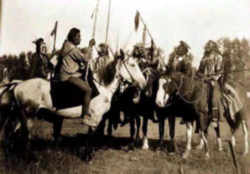


Kentucky Symbols
Kentucky Early History
First Early Inhabitants of Kentucky

Early history examines the archaeological record that tells the story of the first inhabitants of Kentucky. Learn about the prehistory and culture of the first early inhabitants, and what lessons it might teach us about the early history of Kentucky.
Kentucky First Early Inhabitants Timeline
- ca. 13,000 or more to 9500 BC Pre-Paleoindian Period
- ca. 9500 to 8000 BC Paleoindian Period
- ca. 8000 to 1000 BC Archaic Period
- 1500 BC, people of the Woodland culture entered Kentucky. They occupied the area for about 600 years. Efficient hunters and gatherers, the Woodland Indians also participated in an intricate trade network to obtain such things as copper from Lake Superior, obsidian from the Rocky Mountains, and conch shells from the Gulf of Mexico. They mined both Mammoth Cave and Salts Cave for gypsum and mirabilite, a salty seasoning. The Woodland people cultivated corn, sunflowers, giant ragweeds, and amaranth (pigweed), and they raised squash and gourds for containers rather than as a food source. The Woodland Indians buried their dead in conical and later flat or oval-shaped burial mounds, which were often 10 to 20 feet high; this practice resulted in their being called the Mound Builders by 19th-century observers. The remains of two distinct Woodland groups, the Adena (early Woodland) and the Hopewell (middle Woodland), have been found in northcentral Kentucky.
- ca. 1000 BC to AD 1,000 Woodland Period
- 7500 BC, Kentucky's Indian culture changed. Large game animals died out, and the Archaic Indians now depended on fishing and efficient gathering of wild foods as well as hunting. The white-tailed deer and the elk became the dominant game animals. Hunting skills improved with the use of the atlatl, a short wooden board which enabled the Indians to throw their spears farther than with their arms alone. Stone tools, ground to the desired shape, appeared. Artifacts such as grooved axes, conical and cylindrical pestles, bone awls, and cannel coal beads also have been found from this period. A unique feature of the Archaic period was the "hominy hole,"a particular type of depression worn in sandstone by grinding or pulverizing. Despite its name, the hominy hole was probably used for grinding up nuts or seed; corn (from which hominy is made) was not grown in Kentucky until the Woodland period. Shell (mussel) mound sites along the Green, Cumberland, and Tennessee rivers indicate that the Indians returned to the same places year after year. Archaic Indian social groups were probably small, consisting of a few cooperating families. Their dead were buried with bodies flexed in round pits, and sometimes tools were included in the graves.
- 13,000 BC to 1,650 AD - Modern archaeologists classify Kentucky's prehistoric past into six cultures which spanned from 13,000 BC to 1,650 AD These cultures were the Paleo-Indian culture; the Archaic culture; the Woodland culture; the Adena culture; the Mississippian culture and the Fort Ancient culture.
- 900 to 1650 AD The last of the prehistoric peoples were the Mississippian Indians, who lived in western Kentucky from 900 to 1650 AD In the greater Mississippi Valley, these Indians had a well established social order and a full agricultural economy with corn, beans, squash, and tobacco as the principal crops. They hunted with bows and arrows; made pottery in effigy forms; and fashioned large chipped-stone knives, picks, and hoes. These Indians constructed permanent homes of woven branches and plastered mud and protected their villages with wooden palisades (walls made of tall posts) and a moat (wide ditch) outside the palisades. These features gave the villages much the same appearance as the early pioneer forts. Although the Mississippians buried their dead in small burial mounds or stone box graves, they built large flat-topped temple mounds as the ceremonial centers of their cities. Because of this construction design, they have been called the Temple Mound Builders.
- ca. AD 1000 to 1730s Late Prehistoric Period
- 1,650 AD to 1750 - From the end of the Fort Ancient culture in about 1650 until the arrival of the first white settlers, Shawnee tribes from north of the Ohio river and the Cherokee and Chickasaw tribes from south of the Cumberland river fought for control of the "Great Meadow." During this time, no Indian nation held possession of the land that would eventually become Kentucky.
- 1739 - Captain Charles de Longueuil explores Kentucky. The French claimed most of land, established trading posts with help of local Indian tribes
- 1750 - Thomas Walker explores Kentucky through the Cumberland Gap
- 1751 - Christopher Gist explores the region along the Ohio River
- 1754 - The French Indian War (1754 - 1763) is won by Great Britain against the French so ending the series of conflicts known as the French and Indian Wars
Early History of Native Americans in Kentucky
The Indigenous People of Kentucky
The names of the Kentucky tribes included the Cherokee, Chickasaw, Mosopelea, Shawnee and Yuchi.
For many years, writers depicted Kentucky, the Great Meadows of Indian lore, as uninhabited prior to European settlement. They believed that the Indians considered the land sacred and lived elsewhere, coming to the region only to hunt and war. However, almost 3,000 years before Kentucky pioneers came face to face with such tribes as the Shawnee, Cherokee, and Chickasaw, the area had been inhabited by prehistoric Indians. The ancestors of these earliest Kentuckians may have come to the Western Hemisphere as early as 20,000 years ago by crossing a strip of land, now submerged beneath the Bering Straits, connecting the Asian and North American continents. They slowly drifted southward, arriving in Kentucky by 12,000 BC Over many years these early Indians developed four prehistoric traditions which archaeologists have designated as Paleo Indian (12,000-7500 BC), Archaic (7500-1500 BC), Woodland (1500 BC-900 AD), and Mississippian (900-1650 AD).
Kentucky's first human inhabitants were descendants of prehistoric peoples who migrated from Asia over an artic land bridge to North America as long as 30,000 years ago. Even the earliest prehistoric Indians made stone and wooden hunting tools. Archaic people grew squash, and Woodland people expanded by growing corn and beans. The development of pottery in the Woodland Period led to new cooking methods that survived until the arrival of metal cookware.
When Hernando de Soto entered Kentucky on May 10th, 1541, he described one Indian Tribe in Western Kentucky between the Cumberland and Ohio Rivers,
calling them by slightly different names, ranging from Quizquiz (influenced by a place name of renown from DeSoto's Conquest of Peru) to Quizqui to
Chisca, all sounding about the same in their language. The French would call them Casqui and the English Kashinampo. That tribe shared a unique language
with the Casqui of Southern Indiana, the Alabamu of Central Tennessee and the Coste of Eastern Tennessee. They lived next to each other when DeSoto
visited each of them, but that entire Indian language group would be scattered well before being described by later Europeans.
Until the arrival of the first white settlers, Shawnee tribes from north of the Ohio river and the Cherokee and Chickasaw tribes from south of the
Cumberland river fought for control of the "Great Meadow." During this time, no one Indian nation held possession of the land that would eventually
become Kentucky.





